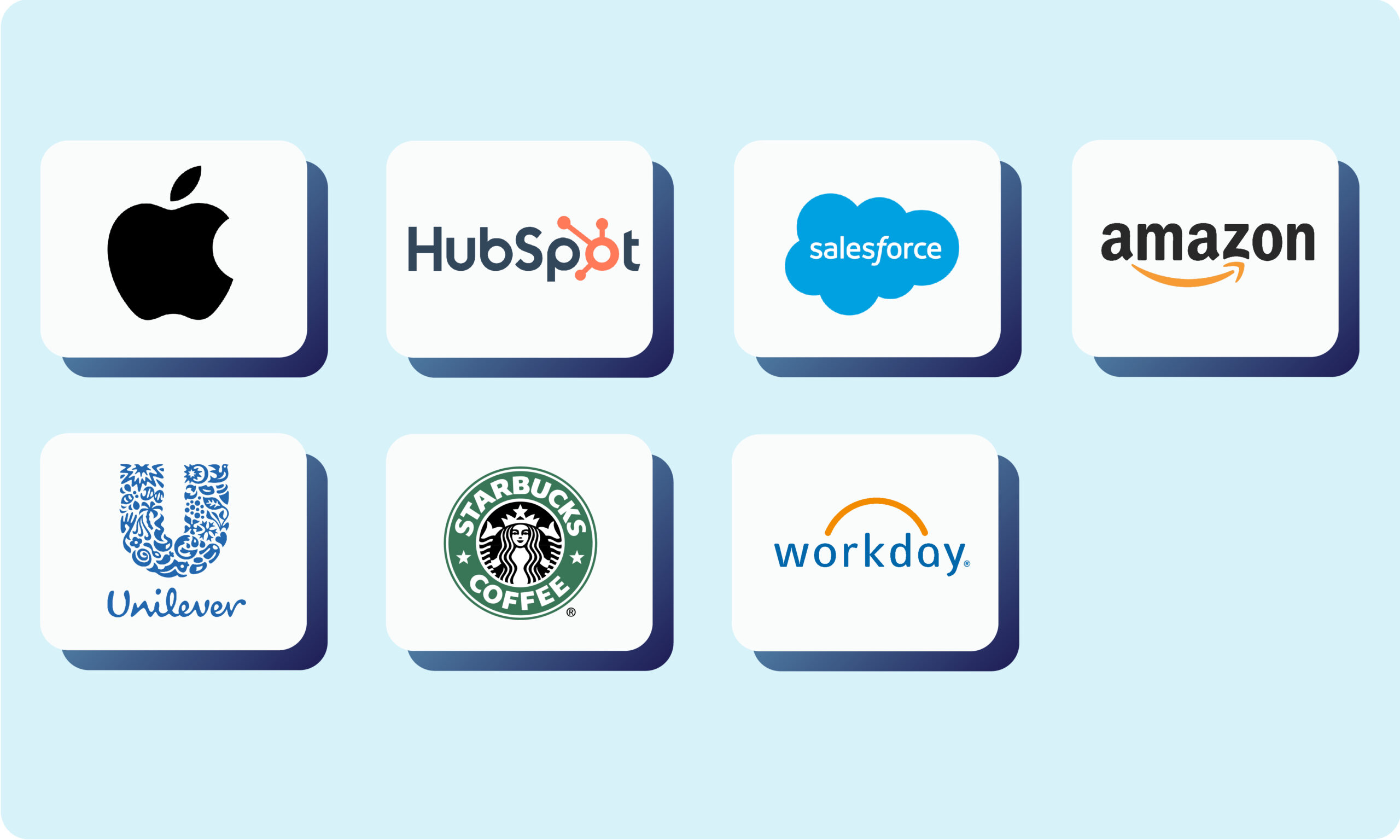Hiring great-fit talent and retaining the employees you already have is a big challenge in today’s recruitment landscape. Every company is putting their best foot forward with one common aim — attracting rockstar employees.
The big question here is how to stand out in the crowd. Well, there’s one powerful tool you might want to fine-tune for the same: your employee value proposition (EVP).
Now, what’s that? Think of it as the secret sauce in your employer brand recipe. It puts the spotlight on what makes working for your company a unique experience. When done right, it’s not just a recruitment trick – a killer EVP can also be the glue that keeps your current employees hooked on your mission and values.
So, how do you create an EVP that leaves a lasting impression? In this blog we’ll dive into the art of creating an employee value proposition and take a look at a few examples that will get your creative juices flowing.
How to Hire and Retain Talent With the Right EVP
An EVP is your company’s appeal to potential candidates, it is the combination of benefits, culture, and opportunities that make your workplace stand out. Consider it the cool factor that makes everyone want to be part of your team.
Your EVP should be relevant and compelling in order to act as a key driver for talent attraction, engagement, and retention. Here’s how an EVP plays a critical role.
- Attracting talent: Employers across the United States added 216,000 jobs to their payrolls in December and, overall, the labor market added 2.7 million jobs in 2023. In the current labor market, your job description must include a lot more than the traditional information to make a mark. Highlight the growth opportunities, emphasize your great team culture, and let potential hires know why your workplace is the right place to be. Your EVP is the key to attracting top-tier talent that fits seamlessly into the organization.
- Retaining talent: The impact of your EVP is equally crucial when it comes to retaining talent. It’s about creating an environment where your employees feel they’re not just doing a job but growing and belonging. A well-defined EVP that focuses on individual growth and well-being helps boost employee engagement and often results in longer tenure.
Best Channels to Build Your EVP
Selecting the most effective channels for conveying your employee value proposition means better reach and resonance. Each communication platform has its strengths, and understanding which one aligns best with your EVP can significantly impact how well it’s received.
Here are some channels to consider.
- Career site: Your website serves as a central hub for information. Ensure your EVP is prominently featured on the careers page, providing a comprehensive overview of what sets your company apart.
- Social media: Platforms like LinkedIn, Twitter, and Instagram allow for engaging visuals and storytelling, giving your EVP a dynamic and shareable presence.
- Internal communications: Channels within your organization are important, too. Utilize email newsletters, internal communication channels like Slack, and team meetings to reinforce your EVP and keep employees informed.
- Events: Industry conferences, job fairs, and company-hosted events can be utilized to directly engage with potential candidates. These face-to-face interactions provide a personal touch, allowing individuals to connect with your EVP on a deeper level.
- Talent marketing campaigns: Launch targeted campaigns that highlight your EVP through various digital channels like blog posts, videos, and testimonials, to create a compelling narrative around your unique proposition.
The key is to meet your audience where they are, creating a seamless and compelling experience across various communication platforms.
From vision and objectives, to understanding underrepresented job seekers, and designing an inclusive approach to hiring, we’ve got you covered.
Looking To Up Your DE&I Game?
Keep Your Communication Consistent
Now that you know how these channels work together to convey your message, it is important to maintain consistent messaging across. Before candidates even apply, they encounter multiple touch points with an employer, ranging from website visits to social media interactions. It’s crucial that your EVP remains coherent across every interaction.
Ensuring this consistency is challenging if you’re manually handling each platform, from website copy to social posts. The most effective solution to tackle this lies in utilizing human resources (HR) technology, equipped with artificial intelligence (AI) and automation capabilities.
By incorporating HR tech into your communication strategy, you can automate messaging, analyze candidate engagement and maintain a consistent brand identity. This ensures that whether a candidate interacts with your website, attends an event, or engages on social media, the core essence of your EVP remains intact.
EVP vs Employer Branding: Navigating the Nuances
In the dynamic world of talent management, employee value propositions (EVP) and employer branding work in tandem to shape an organization’s identity.
An EVP is the essence of what an organization offers its employees, internally. It includes the unique benefits, culture, and opportunities that make working for the company special. On the other hand, employer branding is about a company’s external image – what’s projected to the world. It is the consistent messaging across channels that showcases the company’s values, work culture, and commitment to its employees.
While both these concepts share common ground, they serve different purposes. A company should prioritize aligning the promises of their EVP with the external messages of employer branding to create an authentic and compelling brand value. What people see and hear about a company should align with what they experience.
7 Iconic EVP Examples

The most successful EVPs are capable of talking to a candidate on a personal level. Take a look at how some of the world’s leading brands make their mark.
1. Apple: Join Apple, and Help Us Leave the World Better Than We Found It
This statement is not just a call to contribute to a noble cause; it’s also a promise to employees that their work will have a meaningful
2. HubSpot: Your Best Work Starts Here
This statement means HubSpot believes their employees can keep getting better every day. It gives employees a place to grow and improve. The message is clear – the most impressive work from their employees is yet to come, and HubSpot is there to support them in reaching new heights.
3. Salesforce: The Future of Business Is Equality for All
Salesforce is communicating that everyone is equal and gets the same opportunities to grow professionally. It’s not just about the business itself; it’s about creating a workplace where everyone, regardless of who they are, feels valued and included. Employees can expect a culture that promotes fairness and equal chances for success.
4. Amazon: Work Hard, Have Fun, Make History
Amazon values hard work, but they also want their employees to enjoy what they do. The idea is to make a mark in history, to be part of something significant, while having a great time.
5. Unilever: You are more than your job title.
Unilever sees employees as individuals with unique qualities beyond just the role they have. It emphasizes that each person brings more to the table. They value the diverse skills, experiences, and perspectives that employees bring.
6. Starbucks: Creating a Culture of Warmth and Belonging
This EVP emphasizes efforts to create a welcoming environment where everyone feels included and valued. Starbucks aims to build a sense of togetherness, meaning that each individual contributes to a culture defined by warmth and a deep sense of belonging.
7. Workday: Put People at the Core
At Workday, individuals are at the center of everything. It’s not just about tasks or processes; it’s about recognizing the value of each person and acknowledging that their needs and well-being are fundamental to the company’s approach and operations.
Conclusion
Your employer brand and EVP work together to create your brand image. To make the most of this symbiotic relationship, develop each independently butmaintain cohesive messaging. While they are separate, your employer brand and EVP should always work together to form one consistent brand.
And remember: Be flexible and welcome feedback from candidates and employees. Keep refining your EVP. The essence of success is found in the continuous journey of improvement, where every small step contributes to the overall success of your brand.
See us in action to boost your company’s productivity. Follow us on Twitter and LinkedIn for more hiring insights!
FAQs
What is an EVP?
EVP stands for employer value proposition. It is the unique set of offerings, benefits, and values that an organization promises to provide to its employees.
What are the benefits of a strong EVP?
A strong EVP can attract top talent, enhance employee engagement, improve retention rates, and boost overall performance of the organization. It sets the foundation for a positive employer brand and helps in creating a compelling workplace culture.
How is an EVP different from employer branding?
Employer branding focuses on the overall image and reputation of an organization as an employer. Whereas, an EVP specifically focuses on the unique value and benefits an organization offers to its employees. The EVP concentrates on the tangible and intangible rewards that make an organization an attractive workplace for a candidate.















